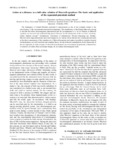
Please use this identifier to cite or link to this item:
http://ricaxcan.uaz.edu.mx/jspui/handle/20.500.11845/552Full metadata record
| DC Field | Value | Language |
|---|---|---|
| dc.contributor.other | https://orcid.org/0000-0001-5324-1834 | es_ES |
| dc.coverage.spatial | global | es_ES |
| dc.creator | Chubykalo, Andrew | - |
| dc.creator | Smirnov Rueda, Roman | - |
| dc.date.accessioned | 2018-06-14T18:14:14Z | - |
| dc.date.available | 2018-06-14T18:14:14Z | - |
| dc.date.issued | 1996-05 | - |
| dc.identifier | info:eu-repo/semantics/publishedVersion | es_ES |
| dc.identifier.issn | 2470-0053 | es_ES |
| dc.identifier.uri | http://hdl.handle.net/20.500.11845/552 | - |
| dc.identifier.uri | https://doi.datacite.org/dois/10.48779%2F645t-0679 | es_ES |
| dc.description.abstract | The inadequacy of Lie´nard-Wiechert potentials is demonstrated as one of the examples related to the inconsistency of the conventional classical electrodynamics. The insufficiency of the Faraday-Maxwell concept to describe the whole electromagnetic phenomenon and the incompleteness of a set of solutions of Maxwell equations are discussed and mathematically proved. Reasons for the introduction of the so-called ‘‘electrodynamics dualism concept’’ ~simultaneous coexistence of instantaneous Newton long-range and Faraday- Maxwell short-range interactions! have been displayed. It is strictly shown that the new concept presents itself as the direct consequence of the complete set of Maxwell equations and makes it possible to consider classical electrodynamics as a self-consistent and complete theory, devoid of inward contradictions. In the framework of the new approach, all main concepts of classical electrodynamics are reconsidered. In particular, a limited class of motion is revealed when accelerated charges do not radiate electromagnetic field. | es_ES |
| dc.language.iso | eng | es_ES |
| dc.publisher | American Physical Society | es_ES |
| dc.relation | https://journals.aps.org/pre/pdf/10.1103/PhysRevE.53.5373 | es_ES |
| dc.relation.ispartof | https://journals.aps.org/pre/ | es_ES |
| dc.relation.uri | generalPublic | es_ES |
| dc.rights | Atribución-NoComercial-CompartirIgual 3.0 Estados Unidos de América | * |
| dc.rights.uri | http://creativecommons.org/licenses/by-nc-sa/3.0/us/ | * |
| dc.source | PHYSICAL REVIEW E Vol. 53, No. 5, p. 5373-5381 | es_ES |
| dc.subject.classification | CIENCIAS FISICO MATEMATICAS Y CIENCIAS DE LA TIERRA [1] | es_ES |
| dc.subject.other | Maxwell equations | es_ES |
| dc.subject.other | separated-potentials method | es_ES |
| dc.title | Action at a distance as a full-value solution of Maxwell equations: The basis and application of the separated-potentials method | es_ES |
| dc.type | info:eu-repo/semantics/article | es_ES |
| Appears in Collections: | *Documentos Académicos*-- UA Física | |
Files in This Item:
| File | Description | Size | Format | |
|---|---|---|---|---|
| 1996-PRE_1996.pdf | 182,42 kB | Adobe PDF |  View/Open |
This item is licensed under a Creative Commons License
